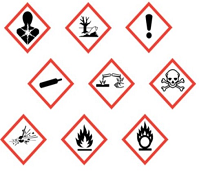
How many languages can you read the word danger in? How about flammable or toxic? If it’s more than three you are above average, but you would still need a warning label to be printed in one of those three languages. Are you willing to bet your health or even your life on that? However, while you probably never thought about where they come from, you probably know what these mean:
These pictograms are designed to be intuitive and warn you of a potential threat. However they are only a part of a larger universal classification and labelling system which identify and classify dangerous chemicals. This system called the Globally Harmonized System of Classification and Labelling of Chemicals (GHS), and is actually a true success story of international cooperation.

The need for something like the GHS comes from a simple fact; we are constantly using chemicals in our everyday lives in some way or another. They are in our soap, our medicines, our clothes and even our food. They are also part of many industrial processes used to develop products that we use every day to make our lives easier, safer and more comfortable. These chemicals are purchased and shipped from all over the world and differences in language and labelling could make exposure to them very dangerous.
So, back in the early 90s the international community recognized that if chemicals are going to be shipped and used worldwide, it would be best if everyone knew how to recognize what was what. Working internationally through cooperation between the United Nations, the International Labour Organisation (ILO), and the Organisation for Economic Co-operation and Development (OECD), the GHS was developed to classify and label chemicals according to their level of hazard. It was adopted and began implementation back in 2002. Currently GHS covers 68 countries around the globe from Argentina, Bolivia, Brazil or the US, to the European Union, Switzerland, Gambia, Nigeria, Senegal, Zambia, Australia, China, Indonesia or the Philippines.

The economic impact for manufacturers is huge since they do not have to conform to different classification and labelling criteria. But most importantly, workers in all 68 countries enjoy the same level of protection thanks to universally agreed classification criteria and hazardous communication element, which includes instantly recognizable pictograms, signal words and hazard statements. These identify the degree and level of the chemical’s hazard, from that of a skin irritant to possible organ damage. So anyone who manufactures, stores, transports, handles or uses these chemicals can identify the hazards posed and apply the appropriate protection measures.

You may actually be aware of one aspect of this system without knowing it. If you live in a country which uses GHS not only in industrial settings but in domestic use as well, you have probably seen the pictograms although though you may never have wondered where they come from. For example, you’ve probably seen the skull and crossbones symbol on a cleaning product. That is actually one of the pictograms meaning toxic.
Or you may have seen a picture of a flame on the side of a can of lighter fluid telling you that it is flammable. The pictograms are only part of the GHS system of course. They are meant to be a flashing red light that says you should read this label or be aware of this danger. The details of the danger the product or chemical poses are in the standardized warning. However, before even reading the warning beneath the skull and crossbones, most people are aware of the nature of the threat because the pictogram is intuitive. If you see skull and crossbones, don’t drink it.
Thanks to GHS, those same pictograms are what you would see in any country applying the system to the same products, would it be Switzerland, New Zealand or Thailand. Today, the UNECE participates in the GHS by providing secretarial services and by contributing to implementation though its own relevant chemical safety legal instruments. This system is another way these types of international agreements keep us safe, sometimes without use even realizing it.

